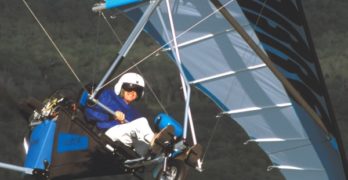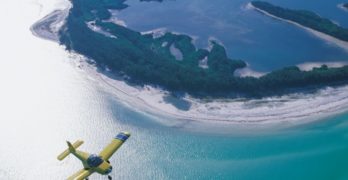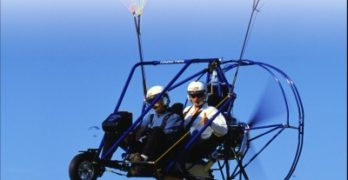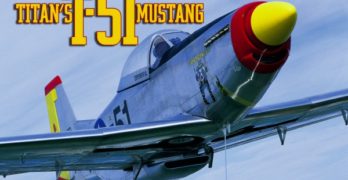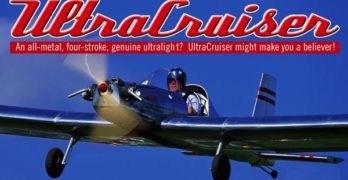Smoother and More Refined
Sabre Aircraft’s Wildcat is an evolving story of ultralight aircraft development. It also speaks to the increasing maturity of the light aviation industry.
For years, Sabre Aircraft’s sales of their various trike models may have been the largest of any U.S. manufacturer. As 2003 ended the company was reporting delivery of some 700 ultralights.
The company has long offered a good flying, simple trike with a modest price tag. Proprietor and designer Richard Helm made steady improvements to his Sabre Elite and Sabre 340 designs. But he took no major strides forward.
The vigorous pace of Sabre trike sales and the company’s need to stay on top of manufacturing issues can explain a drawn-out development period. Little time was left over for projects such as getting an entirely new trike ready for market.
That didn’t stop Helm. He kept working on elements of what would eventually become the Wildcat.
Search Results for : Revo
Not finding exactly what you expected? Try our advanced search option.
Select a manufacturer to go straight to all our content about that manufacturer.
Select an aircraft model to go straight to all our content about that model.
IndUS – Thorpedo
All Revved and Everywhere to Go
This vintage design with a big Jabiru engine is an impressive performer.
Since its reintroduction to the aviation community by IndUS Aviation, John Thorp’s T-211 is generating more attention than at any time since he first designed the airplane.
While John worked on large aircraft, like the Navy patrol bomber P2V Neptune, he focused most of his career on small, sporty aircraft. He began designing a two-place light aircraft in the 1930s. By the 1950s his T-10 Sky Skooter powered by a 50-hp Franklin 2AC-99 engine evolved into the T-111 with a 75-hp Lycoming engine. Later it became the T-211, with a Continental O-200. It is this last version of the T-211 that IndUS now offers as a standard category aircraft. IndUS is also planning to offer the model as a light-sport aircraft (LSA) with a Jabiru 3300 engine, affectionately named the Thorpedo for its improved performance.
Transitioning?
A primer for ultralight pilots transitioning themselves and their machines
Ultralight pilots flying legal Part 103 single-place ultralights are not affected by the sport pilot/light-sport aircraft rule. The rules of FAR Part 103 remain the same. Current and future ultralight pilots are free to enjoy those freedoms. If they choose to become sport pilots at a later date, any training logged as a registered ultralight pilot can be counted toward the training requirements for a sport pilot certificate. The rule pertaining to legal ultralight vehicles also do not change.
The sport pilot and lightsport aircraft (SP/LSA) rule is now officially part of the American aviation culture. Some of us who fly Part 103-legal ultralights will continue to be ultralight pilots. Others who fly two-place or overweight machines must eventually transition themselves to sport pilot status and their machines to light-sport aircraft status to remain legal.
With the rule now final, we’ll address the requirements for those ultralight pilots and instructors wishing to transition themselves and their machines.
Relive the World War II fighter experience
The Ending
In the remainder of this article I’ll tell you what I thought of this new offering from Titan Aircraft, the successful builder of the Tornado line of ultralights and light aircraft. But I must be forthright and tell you my hour and a quarter flight with this new airplane ended with a landing on its belly.
I rush to say it wasn’t simple forgetfulness; I didn’t forget to put the gear down. Instead, a simple mechanical problem in this prototype T-51 prevented the retractable gear from fully extending. The gear was partially down, but it refused to lock in position. A post-incident investigation revealed that a tiny activation pin broke off the gear-down microswitch when I tried to activate it with too forceful a movement. Because the micro-switch didn’t activate, the hydraulic system didn’t push the gear legs down all the way.
Considering the gear was down only about 50 percent, according to Titan President John Williams who was watching from the ground, my touch down was remarkably smooth, and the T-51 rolled for quite a few yards.
Product Lines – November 1998
ST. PAUL, MINN. — Following on bits left over from October’s "Product Lines"… ••• In the land of hurricanes and tropical storms, we find the East Coast’s Turbulent Talent Triangle… I’m referring to the movement of talent, to headhunting (yes, within our little sport!) and to new relationships among leading east coast centers of hang gliding activity. But let’s set the record straight. The east may not have the mountain peaks or the sky-high reputation of the west coast but more students are trained in the east than anywhere in America. Look at the list published every month. Nine months into ’98, three schools accounted for 45% of all Hang Is issues and 35% of all Hang IIs issues (LMFP has 28% and 24% by themselves). From these flight factories come people with experience and that’s the point here. • David Glover, until recently manager of Wallaby Ranch is now at Lookout Mountain Flight Park.
Product Lines – July 1998
Tallard, FRANCE — Across the big drink this month for an airshow lending some international flavor to "Product Lines." ••• Perhaps the most fascinating thing I observed was the proliferation of D-cell wings. The question in my mind is no longer IF D-cell wings will proliferate, but perhaps instead, "Will flex wings survive?" In truth, I don’t see the end of our popular, lightweight, easily folded, easily foot-launched and -landed wings. But I’m less sure of this forecast than I once was. ••• I saw a slightly different version of the Exxtasy called the Revolution (aimed at powered trikes) and two new free flight entries from other manufacturers. • One D-cell wing was from Icaro 2000, builder of the Laminar ST topless flex wing. The other was the Ixbo from Tecma, a French company that few Americans know. La Mouette did not show their Top Secret model. • Icaro’s Lumina is nearly identical to the Exxtasy but uses ailerons versus spoilerons and hooks the pilot’s harness to the controls (versus Exxtasy’s control bar linkup).
Product Lines – June 1997
ST. PAUL, MINN — Back home after attending the big Sun ‘n Fun airshow and just before that another USHGA board of directors meeting in Colorado Springs (the HQ of the association for those of you just back from another planet). ••• One of the evenings involved a little party at Yoo-shga offices. While the directors and a crowd of perhaps 50 persons milled about, someone pulled old copies of this magazine off the neatly organized shelves. Editor Gil Dodgen, myself, and several others enjoyed the memory lane trip of rifling through the old rags. • As many of you recall, this column, starting its nineteenth year with this issue (!!), is a take off from the old Bill Allen "Flying Bull" column that ran back in the late ’70s. When Bill had to step down, he called for a writer to succeed him. When none came forth, I adapted — and always gave credit to Bill for — his style within my own Whole Air magazine.
Product Lines – March 1996
ORLANDO, FLORIDA — Escaping Minnesota’s arctic winter for a few days of work in Florida, this column comes to you from the sunshine state where I got a glimpse of a new design in testing. It shows a distinctly American slant… on a new glider design trend that seems to to be showing strength in Europe. ••• What with winglets last year and internal ribs the year before — well, also ram scoops used by at least two builders before that idea lost momentum — the new notion of "toplessness" appears hot as a pistol. French giant La Mouette already has a glider called the Topless, and German leader Bautek has an entry in the topless sweepstakes named the Sunrise. These gliders have no upper rigging whatsoever. La Mouette is advertising "no kingpost and no compression strut." The Dijon, France-based company also boasts a four Gs negative load capability thanks to a carbon spar.
Product Lines – January 1996
ST. PAUL, MINN. — Welcome to a new year! With the holidays behind us (whew!), you may have some gift cash burning a hole in your harness pocket. I have a few suggestions to help you unburden that pocket. But first… ••• The big news in the safety business is the unanticipated departure of Second Chantz, ballistic parachute maker and marketer of owner John Dunham’s A.I.R. rocket. Second Chantz succumbed to a legal system (with which we’re all-too familiar) that can create huge bills even when a company is unlikely to lose a case. The Reno outfit ceased taking orders on November 1st and will halt all service work January 31st. Too bad, Second Chantz was an innovator that we’ve now lost forever. I wish John well in his new endeavors, namely selling Air Création trikes. As it turns out, Dunham entered an agreement with BRS after closing Second Chantz, so fortunately he’ll still have input to ballistic systems for hang gliding.
All-metal, Four-stroke, Genuine Ultralight
The new light-sport aircraft (LSA) category will soon be a reality. While a best guess is that FAA’s newest rules could be announced at EAA AirVenture Oshkosh later this month, it may happen later in the year. Whenever it happens, and like many others watching closely, I hope this new concept arrives swiftly with its promise of interesting aircraft at affordable prices.
As important as LSA may be, however, the proposed new the rule doesn’t affect other enjoyable flying machines. Aircraft built under the amateur-built (51-percent) rule will continue to be a major factor. Many EAA members are building under this rule, and these aircraft will continue to offer wide choices, performance beyond that of many general aviation aircraft, and the pride of craftsmanship. LSA also leaves room for Part 103 ultralights to continue and grow. While some industry leaders see little demand for single-seat aircraft powered by small engines-and it is true that they do not make up a majority of machines-neither, however, will they disappear.


